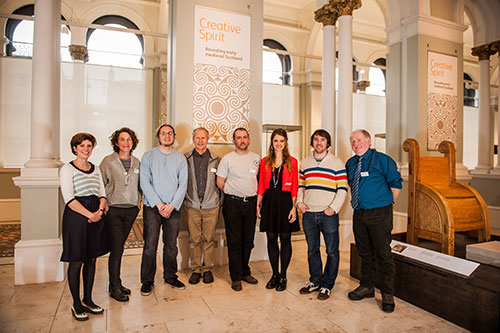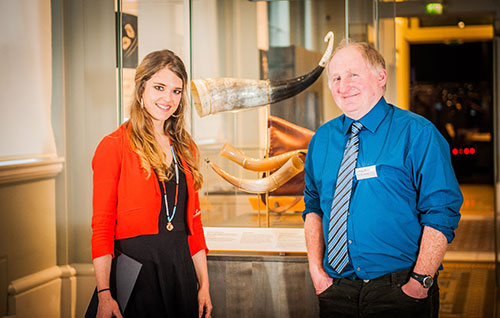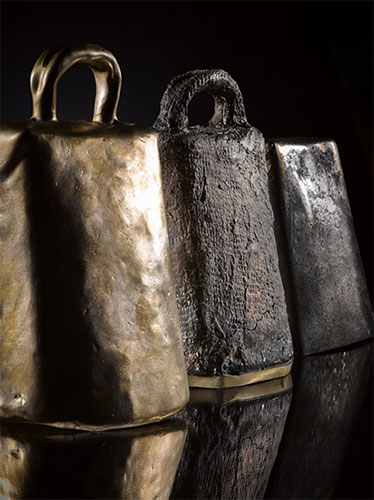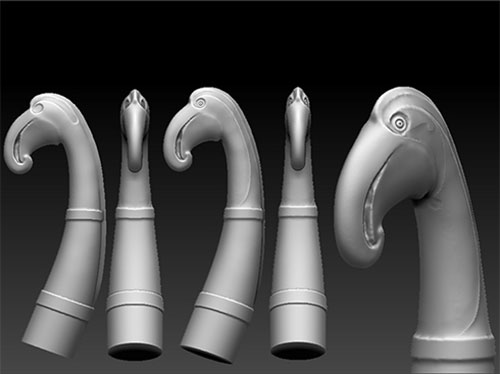How time has flown past! Our special exhibition Creative Spirit only has a few weeks left at the National Museum of Scotland until it closes on 24 February, when the objects will be packed away. So be quick to catch a glimpse of our attempts to breathe life again into Scotland’s rich Early Medieval craft heritage.
Creative Spirit showcases our recreations made in collaboration with artists and craftspeople, employing a wide range of traditional and innovative techniques, both hand-crafted and digital. Working with artists and craftspeople in order to reveal the sophistication of Early Medieval objects has been a privilege.

As an archaeologist I am familiar with rusty, incomplete shadows of objects, worn with the patina of age. Making anew these fugitive fragments from the past has given me an enriched appreciation of the skills involved in past and present craft. I am still in awe of the surprising and bright beauty of the finished pieces! Here I thought I would take the chance to highlight some of the challenges and themes which have arisen from our recreation projects.
For example, the drinking horns made by Johnny Ross of Sutherland Horncraft are glassy and luminous, causing me to re-evaluate my appreciation of horn as a material which is so often considered to be an ancient form of utilitarian plastic. I have fond memories of spending a week up in Sutherland with Johnny documenting the painstaking processes of boiling, scraping and polishing; an arduous but satisfying process!

Martin Goldberg (Senior Curator of Early Historic and Viking Collections) and I have scrutinised and examined Early Medieval hand-bells in our collections and were constantly perplexed at exactly how the bells had been coated inside and out with a thin layer of bronze. In order to solve this mystery, by collaborating with the expert and specialist knowledge at Ratho Byres Forge and Powderhall Bronze, we explored four different methods of making a hand-bell. This was certainly one of the most challenging recreation projects undertaken! Indeed, in the past, there was potentially more than one way to make a brazed iron hand-bell.

This film shows one of the processes we developed for our recreation based on the best preserved brazed iron bell from Scotland, kindly loaned by Birnie Kirk for Creative Spirit.
[vimeo 85237208 w=500&h=280]
For our 3D recreation of the Monymusk reliquary, the challenge here was negotiating the line between imagination and authenticity: our result is not an attempt to make it brand new, but it functions as a complete object and allows privileged close-up and interior views.
[youtube=http://www.youtube.com/watch?v=WUpHowG25Xc&w=500&h=281&rel=0]
This has also made me think about the craft of 3D digital recreation: similar considerations and decisions are involved in virtual recreation as in physical recreation, while you still get a feel of the sensory experience of objects. The opportunity to work with maker and designer Jennifer Gray, who uses a combination of 3D digital carving and traditional silver casting, effectively explored the tension between traditional and new techniques. I feel that the very ethos of the Glenmorangie project is encapsulated in her process, which effectively brings the past alive using innovative tools available to the present generation.

What makes me most excited about digital technology is that it opens up the archive to everybody and offers new possibilities for interrogating objects. The crowd-sourced Pictish Puzzle online laboratory (#PictishPuzzle) developed in collaboration with RelicArte aims to refit thousands of fragments which were chipped off the face of the stunning Hilton of Cadboll stone. This has evolved to become a truly global effort. Log in at www.pictishpuzzle.co.uk to get involved and becomes authors of this recreation!
So now it’s over to you…